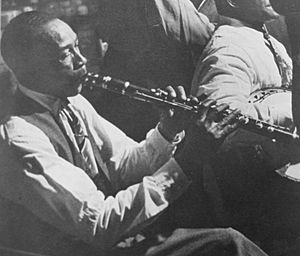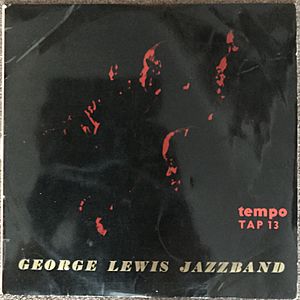George Lewis (clarinetist) facts for kids
Quick facts for kids
George Lewis
|
|
|---|---|

Photograph by Stanley Kubrick published in Look magazine on June 6, 1950
|
|
| Background information | |
| Birth name | Joseph Louis Francois Zenon |
| Born | July 13, 1900 New Orleans, Louisiana, U.S. |
| Died | December 31, 1968 (aged 68) New Orleans |
| Genres | Jazz |
| Occupation(s) | Musician |
| Instruments | Clarinet |
| Years active | 1917–68 |
| Labels | American Music, Decca, Victor, GHB |
George Lewis was a famous American jazz clarinet player. He was born Joseph Louis Francois Zenon on July 13, 1900, in New Orleans, Louisiana. He became very well known later in his life for his amazing music. He passed away on December 31, 1968.
Contents
About George Lewis's Life
George Lewis married Emma Zeno in 1918 in New Orleans. They had four children: Mildred, Joseph, William (Bill), and George (Baby George). George Lewis was a Catholic. He died on December 31, 1968.
George Lewis's Musical Journey
Starting Out in New Orleans
In the 1920s, George Lewis started his own band called the New Orleans Stompers. He also played with other famous jazz musicians like Chris Kelly and Kid Rena. He was a member of two well-known bands: the Eureka Brass Band and the Olympia Orchestra.
During the 1930s, Lewis continued to play with great musicians such as Bunk Johnson, De De Pierce, and Billie Pierce. He recorded music with Bunk Johnson in the early 1940s. He also recorded with Kid Shots Madison.
A Big Break on the Radio
In 1942, a music expert named Alan Lomax invited Lewis to play on a radio show. The show was hosted by Rudi Blesh. On the show, George Lewis played a song called "Woodchopper's Ball". This helped more people hear his music.
Working on the Docks
It was hard for musicians to earn enough money back then. So, George Lewis also worked loading and unloading ships at the Mississippi River docks. In 1944, he had an accident at work. A very heavy container almost crushed his chest.
While he was getting better, he kept practicing his clarinet in bed. His friends, Lawrence Marrero (who played the banjo) and Alcide Pavageau (who played the double bass), brought their instruments to his home. A record producer named Bill Russell also came with his portable recorder.
The Famous "Burgundy Street Blues"
They recorded a special blues song called "Burgundy Street Blues". This song was made up on the spot and became George Lewis's most famous piece. Bill Russell sometimes gave new names to the songs they recorded. This might have been to avoid copyright problems.
Leading His Own Band
George Lewis stayed with Bunk Johnson's band until 1946. They even traveled to New York City and played for dances. Other band members included Jim Robinson, Alton Purnell, and Baby Dodds. While in New York, they recorded for Decca and Victor.
After Bunk Johnson stopped playing, George Lewis became the leader of the band. His band included many talented musicians. They played regularly at clubs on Bourbon Street in New Orleans. They also played on the radio station WDSU.
Growing Fame and Influence
In 1950, George Lewis's band was featured in Look magazine. The famous photographer Stanley Kubrick took the pictures. This helped his reputation grow even more. He became a very important leader in bringing back traditional New Orleans jazz.
In the late 1940s and early 1950s, George Lewis's music reached the United Kingdom. His recordings inspired clarinet players like Monty Sunshine and Acker Bilk. These musicians became very important in the UK's traditional jazz scene. They even played with Lewis when he toured England.
Touring the World
George Lewis visited England in 1957 and played with Ken Colyer's Jazzmen. He returned in 1959 with his full band and was welcomed warmly. In 1959, he also visited Denmark and played at Jazzhus Montmartre in Copenhagen.
Starting in the 1960s, he played regularly at Preservation Hall in New Orleans. He led the Preservation Hall Jazz Band until shortly before he passed away. Artists in New Orleans often painted his performances. The artist Noel Rockmore painted many portraits of Lewis and other musicians who played at Preservation Hall.
A jazz critic named Gary Giddins said that Lewis was a "moving musician" with a "full sound."
Discography
- American Music (American Music, 1951)
- George Lewis’ Ragtime Jazz Band (Tempo Records, London UK 1954?)
- New Orleans Jazz Band and Quartet (Riverside, 1954)
- George Lewis And His New Orleans Stompers (Volume 1) (Blue Note, 1955)
- Jazz in the Classic New Orleans Tradition (Riverside, 1956)
- George Lewis & Turk Murphy at Newport (Verve, 1957)
- Jazz at Vespers (Riverside, 1957)
- The Perennial George Lewis (Verve, 1958)
- Blues from the Bayou (Verve, 1959)
- Jazz at Preservation Hall 4: The George Lewis Band of New Orleans (Atlantic, 1963)
- George Lewis Plays Hymns (1965)
- With Papa Bue's Viking Jazz Band (Storyville, 1991)
- Hot Creole Jazz 1953 (DCC, 1991)
- George Lewis with Red Allen (American Music, 1992)
- In Stockholm (Dragon, 1992)
- For Dancer's Only (GHB, 1993)
- Jazz at the Ohio Union (Storyville, 1994)
- The Beverly Caverns Sessions (Good Time Jazz, 1994)
- George Lewis of New Orleans (Original Jazz Classics, 1994)
- Jazz Funeral in New Orleans (Rykodisc, 1997)
- Reunion (Delmark, 1997)
- At Congo Square (American Music, 1998)
- George Lewis in Hi-Fi (Upbeat, 2008)
See also
 In Spanish: George Lewis para niños
In Spanish: George Lewis para niños


